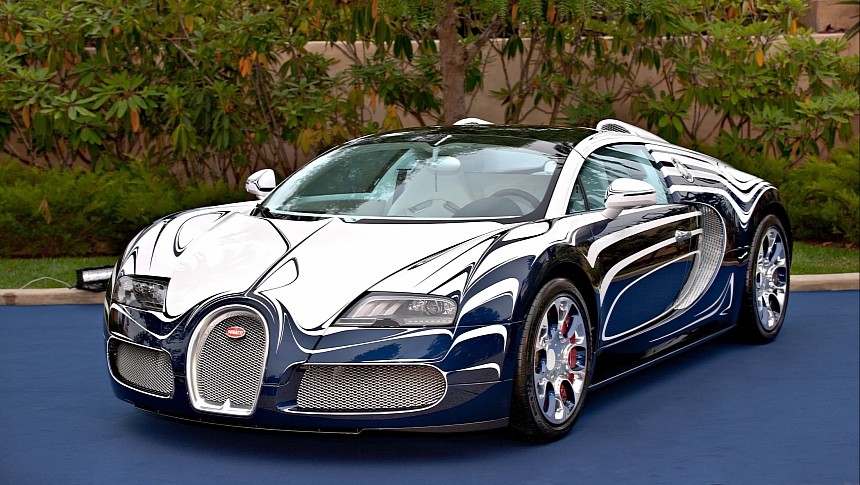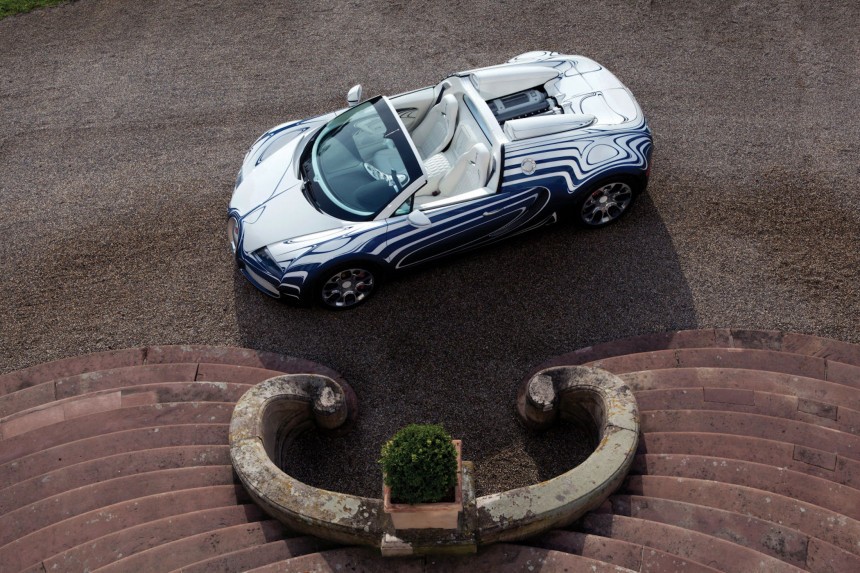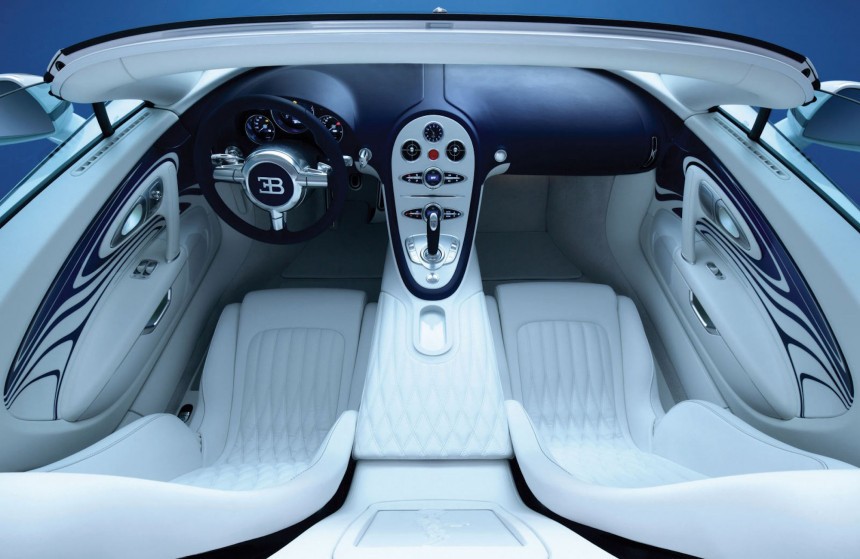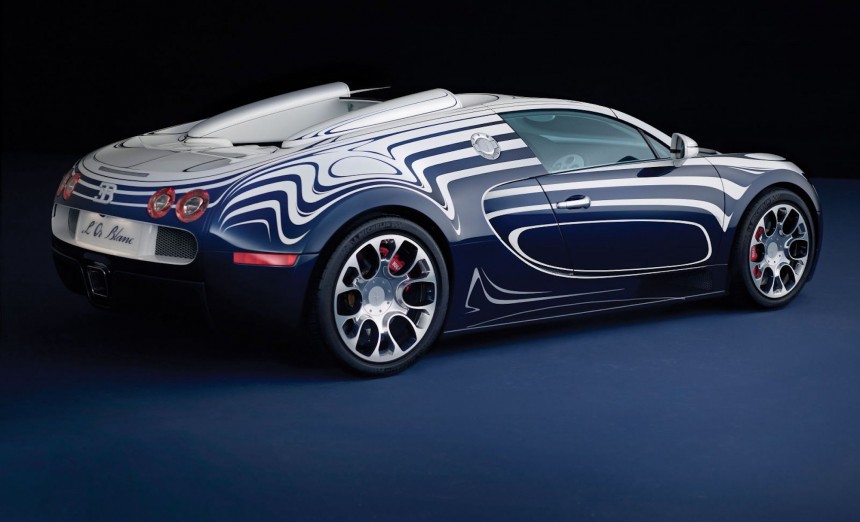A one-off. The most exclusive of exclusives. The Bugatti L'Or Blanc. That is French for White Gold. And in this case, the white gold is porcelain. Yes, Bugatti once built a car from porcelain, rated at over $2 million, and has been keeping the name of the buyer a secret ever since.
L'Or Blanc was the result of the collaboration between Bugatti and the Royal Porcelain Factory (Königliche Porzellan-Manufaktur - KPM) in Berlin, Germany. They labeled it as the fastest porcelain. We'd dare label it as the only porcelain with a speedometer. But it was, indeed, the first – and last car, as far as we know – to feature porcelain inlays on the interior and on several exterior parts, such as the fuel filler cap, badges, and wheel center caps, for instance. An automotive piece of art running at over 250 mph.
You don't go around driving a car made from porcelain as much as you would drive a Bugatti, which is mostly a garage queen, and expect it to hold up forever. But That is why Bugatti only made one.
The Moselheim carmaker premiered the car in a ceremony, which took place on June 30, 2011, at the KPM headquarters in Berlin. It was based on the Veyron Grand Sport, and it looked extravagant and abstract and everything in between.
The project was coordinated by Bugatti's Head of Design, Achim Anscheidt. His team worked quietly for months to get the car ready on time. They stop, take a step back, look at it, bend up and down to see how the light falls on the car, how the porcelain parts shine from different angles, how they reflect light, and then start again.
The Veyron Grand Sport was, back then, the fastest convertible in the world. It needed looks to match that performance. It could hit 254.04 mph (408.84 kph). That is not something you get to see on the race track, not to mention the street.
They call it L’Or Blanc. The White Gold. Simple as that. The body is pre-painted in a bright white tone that looks so porcelain-ish. To draw the blue lines, they used a precision tape of Japanese soft tissue that can be torn off by hand with ease and sticks to sulfur-containing plasticine perfectly.
When stretched, the tapes are lined in pieces of up to 16.4 feet (5 meters) across the entire body of the Veyron. A correction tape above the original tape is placed when necessary. This happens again and again until the final line has just the right tension and position. Even the smallest imperfections have to be corrected with meticulous attention. When the design is completed, a grid of light reflections shows up on the car.
Then the carmaker's paint specialists fill by hand each millimeter of the marked lines. Five layers of clear lacquer and three weeks later, the Bugatti L'Or Blanc is ready. In the lower section of the convertible, blue lines dominate over the white spaces. The pattern inverts toward the roof, so the white becomes dominant.
There are twelve elements made of porcelain on the model, all made at the factory in Berlin. That is where more than 170 craftsmen and experts produce the items by hand. Each unique item takes several weeks to be completed. This was the case for the porcelain components designed for the Bugatti as well.
Molding, testing, checking the impact of natural shrinkage, which is about 16 percent during firing and drying, making sure they fit perfectly and hold up in every driving situation, and then fitting them to the car when completed were major challenges for the team in Berlin. The factory has been operating for 261 years. But they never had to deal with a car. So they also had to thoroughly inspect each item to make sure they would not turn into danger for the occupants in case of a crash.
And this is how the Bugatti L'Or Blanc became the first car ever to feature porcelain components. The inlays of the center wheel badges are made of it, and so are the fuel filler cap and the oil filler cap. The signature "EB" (standing for "Ettore Bugatti") is also in porcelain.
The material found room on board the Bugatti Veyron-based one-off. It shows up on the sides of the center console, but also on the rear panel between the seats. And then, there is the fine porcelain dish with edges finished in diamond polishing, a technique that KPM used for the first time. The dish is part of a picnic set, exclusively designed by the porcelain factory for the high-end model.
When Bugatti started flirting with the idea of fitting porcelain components to what was then the world's fastest convertible, it was unusual, to say the least. But hey, that was Bugatti. It didn't scare them off. They took on the challenge. They knew Ettore Bugatti would go for it. So they did, too.
KPM originally intended to integrate the renowned elephant sculpture, designed by Rembrandt Bugatti, into their product lineup. But then, from one idea to another, the porcelain artisans joined forces with Bugatti to roll out an exclusive automobile: Bugatti L'Or Blanc.
This piece of automotive art, this artistry on wheels, came for 1.65 million euros back then, which translated to $2.3 million. Who bought the car? Bugatti has been keeping this secret for over a decade. But the car has been spotted in Paris and Monaco, so that means that it should be a customer based in Europe.
You don't go around driving a car made from porcelain as much as you would drive a Bugatti, which is mostly a garage queen, and expect it to hold up forever. But That is why Bugatti only made one.
The Moselheim carmaker premiered the car in a ceremony, which took place on June 30, 2011, at the KPM headquarters in Berlin. It was based on the Veyron Grand Sport, and it looked extravagant and abstract and everything in between.
The project was coordinated by Bugatti's Head of Design, Achim Anscheidt. His team worked quietly for months to get the car ready on time. They stop, take a step back, look at it, bend up and down to see how the light falls on the car, how the porcelain parts shine from different angles, how they reflect light, and then start again.
They call it L’Or Blanc. The White Gold. Simple as that. The body is pre-painted in a bright white tone that looks so porcelain-ish. To draw the blue lines, they used a precision tape of Japanese soft tissue that can be torn off by hand with ease and sticks to sulfur-containing plasticine perfectly.
When stretched, the tapes are lined in pieces of up to 16.4 feet (5 meters) across the entire body of the Veyron. A correction tape above the original tape is placed when necessary. This happens again and again until the final line has just the right tension and position. Even the smallest imperfections have to be corrected with meticulous attention. When the design is completed, a grid of light reflections shows up on the car.
Then the carmaker's paint specialists fill by hand each millimeter of the marked lines. Five layers of clear lacquer and three weeks later, the Bugatti L'Or Blanc is ready. In the lower section of the convertible, blue lines dominate over the white spaces. The pattern inverts toward the roof, so the white becomes dominant.
Molding, testing, checking the impact of natural shrinkage, which is about 16 percent during firing and drying, making sure they fit perfectly and hold up in every driving situation, and then fitting them to the car when completed were major challenges for the team in Berlin. The factory has been operating for 261 years. But they never had to deal with a car. So they also had to thoroughly inspect each item to make sure they would not turn into danger for the occupants in case of a crash.
And this is how the Bugatti L'Or Blanc became the first car ever to feature porcelain components. The inlays of the center wheel badges are made of it, and so are the fuel filler cap and the oil filler cap. The signature "EB" (standing for "Ettore Bugatti") is also in porcelain.
The material found room on board the Bugatti Veyron-based one-off. It shows up on the sides of the center console, but also on the rear panel between the seats. And then, there is the fine porcelain dish with edges finished in diamond polishing, a technique that KPM used for the first time. The dish is part of a picnic set, exclusively designed by the porcelain factory for the high-end model.
KPM originally intended to integrate the renowned elephant sculpture, designed by Rembrandt Bugatti, into their product lineup. But then, from one idea to another, the porcelain artisans joined forces with Bugatti to roll out an exclusive automobile: Bugatti L'Or Blanc.
This piece of automotive art, this artistry on wheels, came for 1.65 million euros back then, which translated to $2.3 million. Who bought the car? Bugatti has been keeping this secret for over a decade. But the car has been spotted in Paris and Monaco, so that means that it should be a customer based in Europe.












